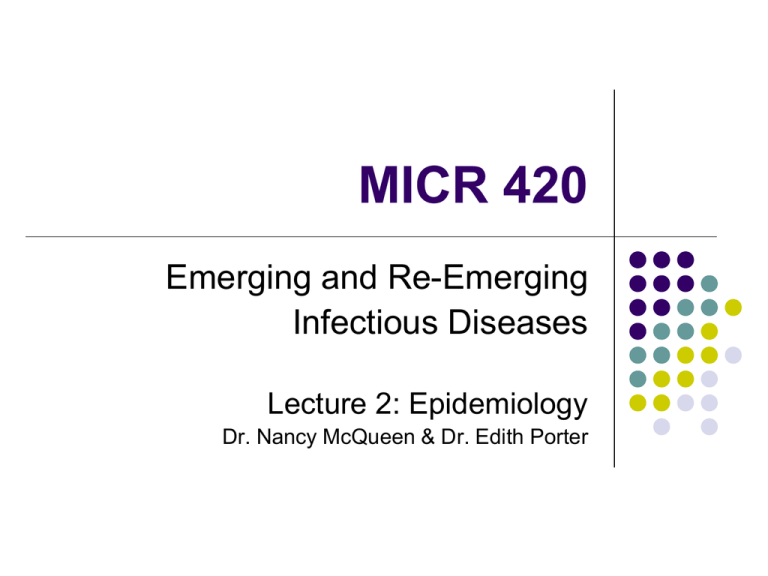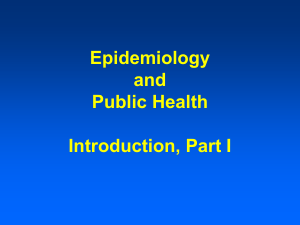
MICR 420
Emerging and Re-Emerging
Infectious Diseases
Lecture 2: Epidemiology
Dr. Nancy McQueen & Dr. Edith Porter
Overview
Concepts of epidemiology
The cycle of microbial disease
Reservoirs of infection
Transmission
Portals of entry
Portals of exit
Nosocomial infections
Epidemiology of fear
What is Epidemiology?
As told by CDC …
It seems that one of their scientists, on first arriving at CDC from a
clinical practice, found himself somewhat unsure of what
epidemiology was all about, so he sought an answer down the street
at Emory University.
The first person he asked was a medical student, who told him that
epidemiology was "the worst taught course in medical school."
The second, a clinical faculty member, told him epidemiology was
"the science of making the obvious obscure." Finally, knowing
that statistics are important to epidemiology, he asked a
statistician, who told him that epidemiology is "the science of long
division" and provided him with a summary equation. Giving up on
finding a real answer, he returned to CDC. On the way, however, he
decided to try one more time. He stopped a native Atlantan who told
him that epidemiology was "the study of skin diseases.”
What is Epidemiology really?
Study—Epidemiology is the basic science of public health. It's a
highly quantitative discipline based on principles of statistics and
research methodologies.
Distribution—Epidemiologists study the distribution of frequencies
and patterns of health events within groups in a population. To do
this, they use descriptive epidemiology, which characterizes health
events in terms of time, place, and person.
Determinants—Epidemiologists also attempt to search for causes
or factors that are associated with increased risk or probability of
disease. This type of epidemiology, where we move from questions
of "who," "what," "where," and "when" and start trying to answer
"how" and "why," is referred to as analytical epidemiology.
What is Epidemiology really?
Health-related states—Epidemiology as it is practiced today is
applied to the whole spectrum of health-related events, which
includes chronic disease, environmental problems, behavioral
problems, and injuries in addition to infectious disease.
Populations—One of the most important distinguishing
characteristics of epidemiology is that it deals with groups of
people rather than with individual patients.
Control—Epidemiological data steers public health decision
making and aids in developing and evaluating interventions to
control and prevent health problems. This is the primary function
of applied, or field, epidemiology.
History of Epidemiology
Hippocrates in 460 – 377 B.C.
Edward Jenner in late 18th century
Childbed fever (puerperal sepsis)
John Snow
Cow pox protects from small pox
First vaccination
Ignaz Semmelweis
Malaria associated with swampy environments
Cholera outbreaks in London
Florence Nightingale
Epidemic typhus
in mid 19th century
Ignaz Semmelweis and
Puerperal Sepsis
Mandatory
hand washing
introduced
John Snow and Cholera
Cholera epidemics in London 1846
– 1849
Snow analyzed the death records
and interviewed survivors
Created map
Most individuals who died of
cholera used water from Broad
street pump
Survivors did not drink water but
beer instead or used another
pump
Identified the Broad street water
pump as likely source
After closing this pump number of
cholera cases dropped significantly
Florence Nightingale and
Epidemic Typhus
Recorded statistics on epidemic
typhus in English civilian and
military populations
Published a 1000 page report in
1858
Statistically linked disease
and death with poor food
and unsanitary conditions
Novel graph: coxcomb chart
or polar area diagram chart
Fixed angle and variable radii
Resulted in reforms in the British
Army
Nightingale became the first
female member of the Statistical
Society
Investigation Types in
Epidemiology
Experimental
Epidemiologist is in control of the circumstances at the beginning of the study
Begins with a hypothesis
Prospective study that usually involves controls
Example: Semmelweis’ study; vaccine efficacy trials
Observational
Epidemiologist is not in control of the circumstances at the beginning of the study
Descriptive
Collect data about affected individuals, the places and the periods in which disease
occurred (Who? Where? When?)
Typically retrospective
E.g. Snow’s study
Analytical
Analyzes a particular disease to determine its probable cause (How? Why?)
Case control method – look for factors that might have preceded the disease
Cohort method – study of two populations, one having had contact with the disease agent
and the other that has not
E.g., Nightingale’s study
Case Reporting
Health care workers are required to report specified diseases to
local, state, and national offices
Centers for Disease Control
and Prevention (CDC)
Branch of the U.S. Public Health Service
Collects and analyzes epidemiological information in the U.S.
Publishes Morbidity and Mortality Weekly Report (MMWR)
www.cdc.gov
Morbidity: incidence of a specific notifiable disease
Mortality: deaths from notifiable diseases
Morbidity rate: number of people affected/total population in a given
time period
Mortality rate: number of deaths from a disease/total population in a
given time
Notifiable Diseases
Reported to the CDC
To detect reemergence
of disease and be able
to respond early
List includes
AIDS
Anthrax
Botulism
Cholera
Cryptosporidiosis
Diptheria
Ehrlichiosis
Encephalitis (arboviral)
Enterohemorrhagic E. coli
Hanta virus
Hepatitis, viral
Malaria
Meningococcal disease
Pertussis
Streptococcal diseases,
invasive Group A
Tuberculosis
VISA, VRSA
Frequency and Distribution of
Disease
Sporadic disease
Disease that occurs
occasionally in a
population at irregular
intervals
Epidemic disease
Endemic disease
Disease continually
present in a population at
low frequency and a
steady level
High frequency over
short time
Disease acquired by
many hosts in a given
area in a short time
Disease with sudden
increase of morbidity
(illness rate) and
mortality (death rate)
above the normal level
Common source versus
propagated
Pandemic disease
Worldwide epidemic
Classification of diseases by frequency
and distribution
Difference between Endemic
and Epidemic Disease
Microbiology: An Evolving Science
W. W. Norton & Company, Inc.
© 2009
Source and Spread of Major
Epidemics
Common-source
epidemic
Propagated or
Disease spread from one
source
Little transmission from
infected (e.g., food
poisoning)
Propagated epidemic
Disease continuously
transmitted from infected
Higher numbers, longerlasting epidemic (e.g. flu)
Herd Immunity
Large fraction of a population is immune to a
given disease, and it is difficult for the
disease to spread (proportion immune
individuals needed depends upon type of
infection)
Cycle of Microbial Disease
Reservoir
Portal of exit
Transmission
Disease
Portal of entry
Reservoirs of Infection
Where do you get the infection from?
Site in nature where microbes survive (and possibly multiply)
Continual sources of infection
Humans
Small pox, gonorrhea
Active carriers: acutely ill
Healthy carriers: no symptoms
Living reservoirs
inapparent infections or latent diseases
Example: Typhoid Mary
Animals
Zoonoses
Rabies, Lyme disease
Fomite
Soil, water
Botulism, tetanus
Non-living reservoirs
Transmission
How do you get the infection?
Direct
Requires close association
between infected and
susceptible host
Person – to – person
Horizontal
Vertical
Mother – to – child
Animal bites
Indirect
Vehicle (fomites, water)
Airborne (aerosols)
Vector
Fecal-oral
Droplet
Epidemiological Vectors
Arthropods
Invertebrates with jointed appendages
Ticks, flies, mosquitoes, fleas
Mechanical vector
Biological vector
Plague
Malaria
Trypanosomiasis
Microbe proliferates in arthropod
Necessary component in the life cycle of the microbe
Sometimes transovarial transmission
Lyme Disease:
Skin manifestation
Tick
Borrelia burgdorferi
Portals of Entry and Exit
Respiratory tract
Intestinal tract
Urinary tract
Genital tract
Skin
Blood
Mucous membranes
Nosocomial Infections
Acquired by compromised hosts during a hospital
stay
5-15% of all hospital patients
50% of all major hospital complications
At 2 – 4 million admissions/year estimated 20,000 –
40,000 deaths per year in the US
Body Site Distribution of
Nosocomial Infections
Factors Contributing to
Nosocomial Infections
Patient population is immune comprised
Misuse of antibiotics with development of
antibiotic resistant strains
Medical devices as new portals of entry
Hospital staff as reservoir
Control Measures against
Nosocomial Infections
Appropriate use of antibiotics
Safe and effective decontamination and
sterilization
Staff hygiene
Hand washing
Screening of all hospital patients?
Epidemiology of Fear
Fear with epidemic proportions
Example: West Nile Virus (CDC national data)
2006: 5000 infections with 180 deaths
2007: 3600 infections with 121 deaths
2008: 1356 infections with 44 deaths
2009: 663 infections with 30 deaths
Not a public threat!
Take Home Message
Epidemiological classification of disease is based on
frequency and distribution as sporadic, endemic,
epidemic, and pandemic.
The cycle of microbial disease includes reservoir,
transmission, portal of entry and portal of exit.
Transmission may be direct from person to person
or indirect through an intermediate agent such as a
fomite or a vector.
Nosocomial infections are hospital acquired
infections often caused by multidrugresistant
microorganisms.
Additional Resources
The Microbial Challenge, by Krasner, ASM Press,
Washington DC, 2002.
Brock Biology of Microorganisms, by Madigan and
Martinko, Pearson Prentice Hall, Upper Saddle River,
NJ, 11th ed, 2006.
Tortora et al., Chapter 14
http://www.cdc.gov/excite/classroom/intro_epi.htm
http://users.rcn.com/jkimball.ma.ultranet/BiologyPages/J/JohnSnow.gif
http://www.gazellebookservices.co.uk/Military/originals/Military/19th%20Century/Flore
nce%20Nightingale%20and%20the%20Crimean%20War.jpg
<http://www.britannica.com/eb/art-70822>.
http://www.cdc.gov/ncphi/disss/nndss/phs/files/NNDSS_event_code_list_January_20
10.pdf




